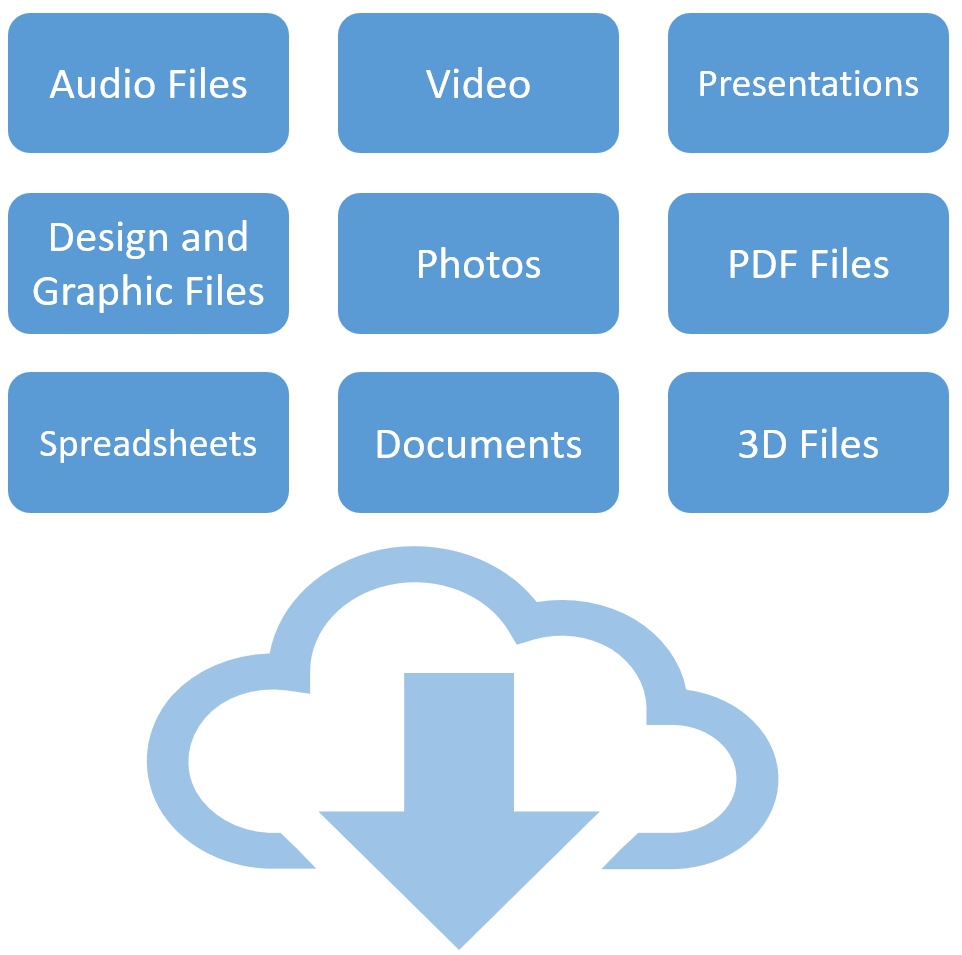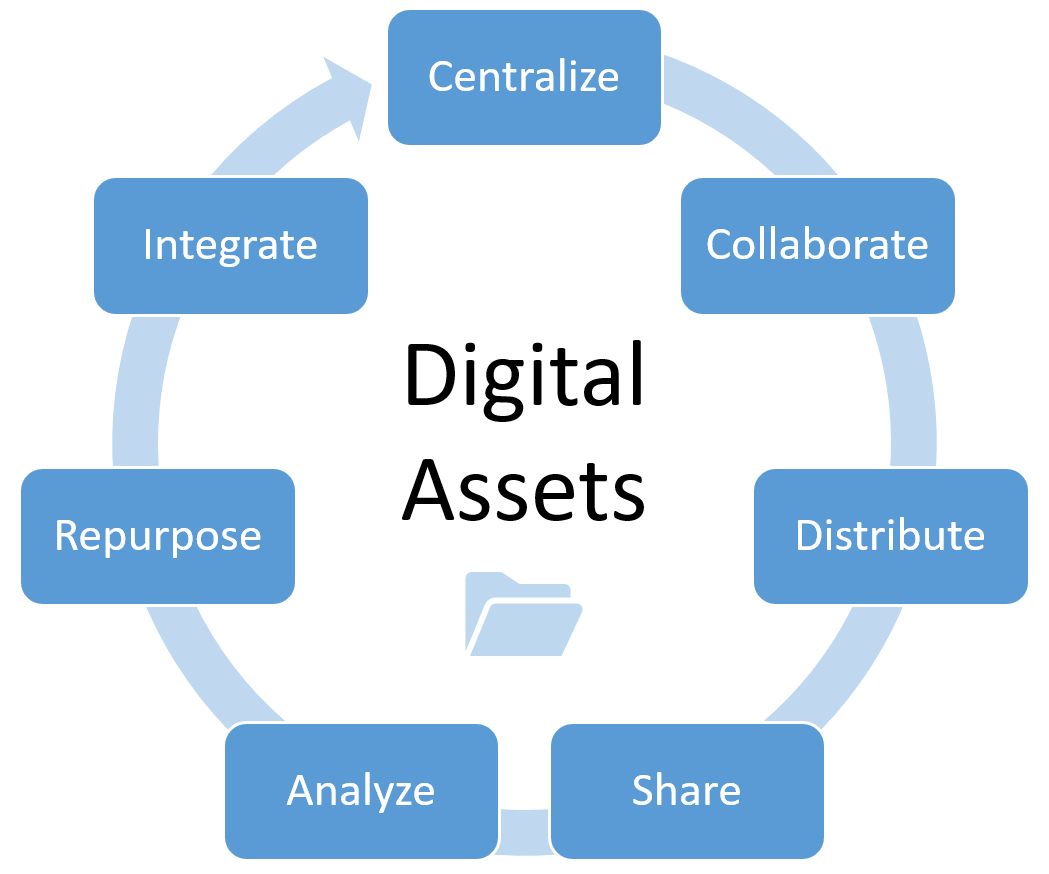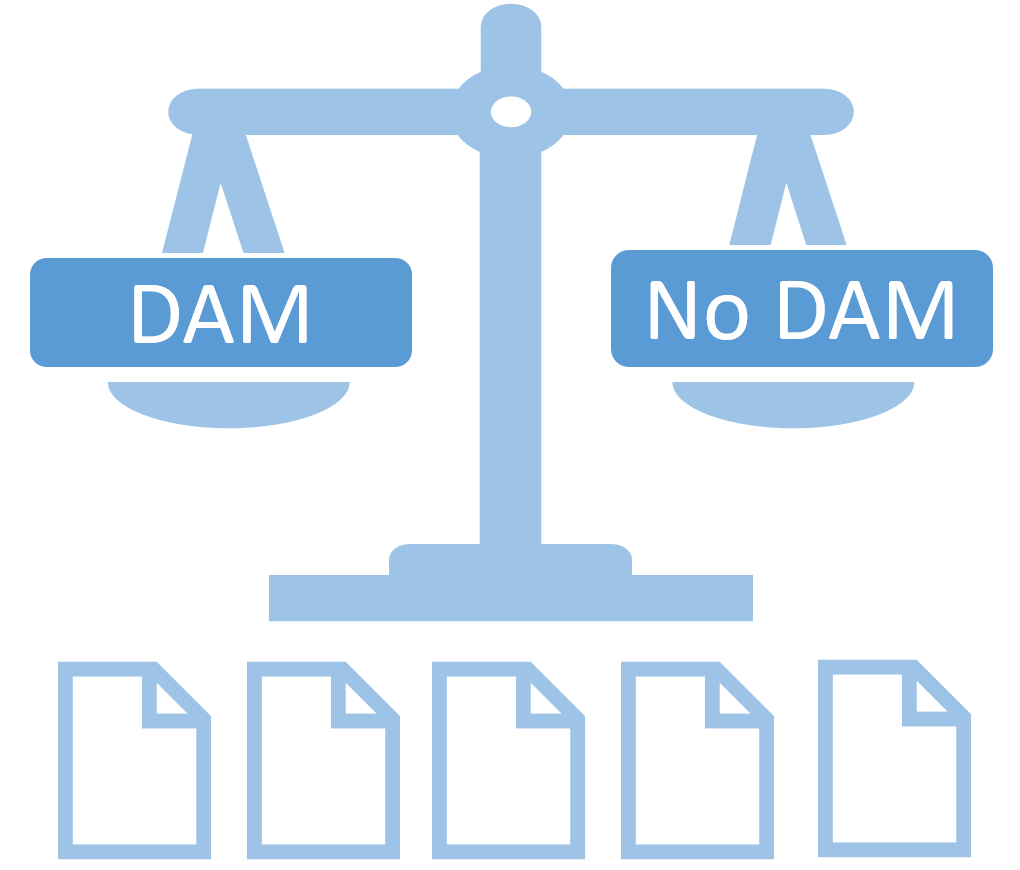
Table of Contents
- What is a Digital Asset?
- What is Digital Asset Management - DAM Definition
- Why you need a DAM and what problems does it solve?
- Who should use a DAM and what for?
- Why is DAM software so popular?
- DAM requirements are demanding
- How to select an appropriate DAM System?
- DAM Features
- Types of Digital Asset Management Systems - cloud-based vs. on-premise
- DAM advantages and disadvantages
- Which systems can a DAM be used with?
- Does a DAM system pay off?
- Conclusion
It isn’t easy In the modern world for a company to stand out from the competitors. Marketing teams face more work, because communications take place mainly online, and these often include visual aspects. Digital content has, therefore, become an important brand feature.
In this article, we will explain in detail what Digital Asset Management is, how it works, what problems it solves, which features and advantages it offers and which companies could benefit from implementing it.
What is a Digital Asset?
Digital assets are files, that exist in digital format providing value for the company or individual who owns it. Digital assets may include digital documents, spreadsheets, audio files, digital content, images, logos, videos and motion pictures, graphic files, illustrations, 3D files and more. In a broad sense, you could consider any digital file a digital asset.

Additional value for the digital assets is created by metadata. Metadata is data about other data. It describes in a structured form the specifications and characteristics of the digital assets. Usually metadata is stored directly within the referred file, but it is also sometimes stored separately. Both options are made possible through Digital Asset Management Systems.
What is Digital Asset Management - DAM Definition
Digital asset management (DAM) is the process of managing digital content or digital assets. Digital asset management is usually facilitated by DAM software.
Digital asset management software is a system for the secure upload, storage, organization, management, sharing and distribution of digital assets. In most cases, we refer to digital media content such as images, photos, graphics, videos, audio files, PDFs and all types of spreadsheet or digital document. In the media sector, DAM is sometimes also referred to as media asset management (MAM) or, more specifically, video asset management (VAM).
DAM is a centralized digital repository, which provides access to the digital assets for the company employers, data suppliers, contractors, clients and other involved parties. It improves the productivity and effectivity of marketing teams and saves costs by structuring and organizing the company’s creative processes.
The software helps content managers and marketers to seamlessly manage and simplify the creative processes, approvals and compliance. Thus, the DAM system is much more than just an asset management tool.
Why you need a DAM and what problems does it solve?
When it comes to the use of digital assets marketing teams face a variety of problems. These problems include:
- scattered storage
- badly organized data
- simultaneous use of different digital asset versions.
DAM is primarily needed for internal central storage of all the company’s digital assets. It is used to organize collaboration between the internal and external users who need access to these assets. Different departments, mainly marketing and sales, can then use the assets internally. You can also make them available externally to various contractors who need access to your brand and marketing materials. Having all the digital assets in a single location allows for simpler, organized distribution.
The system facilitates adherence to brand standards and ensures a consistent brand experience over all marketing channels.
Moreover, digital publishing functions allow you to publish your digital assets on social media channels, marketing automation systems, websites and so on.
Not all companies dealing with digital assets require a DAM system. It is typically used by companies with a lot of digital media content that they’re battling to organize and use these digital assets. If you experience any of the following, you should consider using the software:
- own a lot of digital assets
- single use of assets, because it is difficult to find those assets again
- have difficulty tracking marketing problems
- have problems with brand and marketing consistency
- not sure about rights of usage for your assets
- have security issues
- it is sometimes hard to find a proper version of the asset
- have issues converting assets to the required formats
- have trouble cooperating on assets with other colleagues and collaborators
- your marketing campaigns are not consistent across different channels.
Businesses across industries interested in optimizing current digital asset processes and workflows needs a DAM software solution. The main challenges in choosing the right system include
- It should be easy to find any asset on the system
- Assets should be available whenever and wherever you need them
- Creative collaboration should be simplified and better organized
- The system should ensure an appropriate level of security
- DAM usage should save working time, not extend it.
Who should use a DAM and what for?
Internal Users
Sales Managers and Marketers can collaborate in creating, managing and distributing marketing and brand materials. The systems are adaptable to the needs of different regional markets and languages. A good system should enhance brand consistency across all distribution channels. These materials are usually approved for use in the future sales pitches and presentations directly in the DAM system. Version control in the system ensures that the very last asset versions are used in production.
Designers use the DAM software to optimize their creative processes. After creating new digital assets they are uploaded onto the DAM system. Assets can be transformed and optimized directly in the system if required.
Photographers can upload new photos for further reviews, enrichment with metadata information and distribution in the DAM system.
Legal managers may store asset licenses along with the expiration dates of the assets. Role management and permission control ensures that only people who need access get it. Only authorized assets can be used.
The DAM system makes life easier for IT Professionals, because they’re no longer responsible for any additional environments for storage and exchange of digital assets nor do they have to organize collaboration between different parties. Ensuring file security is easier to implement. Even if DAM is internally maintained, it is easier to manage a single system that fulfills a full list of “digital” requirements. With these systems you can completely automate data exchange with third-party systems thereby reducing the number of mistakes made.
External Users
Agencies can use the software to store customer-related assets, then, present these assets to the customers and gather feedback. Assets may be shared between team members working on the same project or campaign. Such assets are well-organized, ensure consistency and create a professional look for the customer while matching the brand.
Channel partners, Distributors, Contractors and other Partners can receive last versions of well-structured and approved digital content for their marketing campaigns. These on-brand materials are easy to update. Thus, a DAM system helps to organize collaboration and data exchange and simplifies communication.
Why is DAM software so popular?
Modern businesses promote their merchandise through digital content delivered across all channels and devices ensuring uniform brand and product communication. The first step in enabling this is to store and manage assets centrally.
Digital Asset Management is more than just a storage space for different files. You have to create and interact with asset metadata, if you are to realize the full potential of the asset. Metadata creates real value for digital assets, describing the asset, providing context and making it possible for people to search for the asset.
Digital assets visually represent a brand or product in the proper way – making it attractive and uniform for the end customer over all channels. Digital Asset Management has become an invaluable tool for effective omnichannel marketing and one of the most important tools for marketers and sales managers who want to make their jobs easier.
Modern solutions actively use artificial intelligence and machine-learning for asset tagging and to serve appropriate, and relevant content to various customer target groups.
DAM requirements are demanding
Every adopter has to create an own list with DAM requirements for future software requirements. This is because each company has different processes for creating, management, distribution and publication of their assets. Some may have their own graphic designers and PR teams, others may use the services of freelancers or specialized agencies.
Nevertheless, typical requirements include:
- scalability – the system should be scalable to enable the business to grow
- functional scope – software should have all the functions needed to cover actual and future business needs
- integrability – it should be easy to integrate the system in your company’s system landscape
- adaptability – the system should be easy to adapt to your business processes and workflows
- remote accessibility – it should be possible to use the system whenever and wherever you need it.
How to select an appropriate DAM System?
There are many solutions on the market, so choosing a appropriate system is not easy.
To start with it is important to identify the people, who will use the system, and processes which the DAM will cover. Create a list with features you’d like to see in your future solution. Don’t forget to consider non-functional requirements such security issues, which you should also include on your list.
Finally, once you’ve gathered and described all the requirements, it’s time to identify the DAM vendors who can supply your needs. Make the first contact. Ask the supplier to comment on your requirement list. Now, you can narrow down the list of potential providers to 2 or 3 and invite them to present their software.
DAM Features
As already mentioned Digital Asset Management is about storage, organization, usage, sharing and distributing your digital assets and automating the related processes. DAM software can simplify the creative workflow, usage tracking and permissions.

DAM systems often have varying features depending on the target group of users, but core features should be the same for all:
- import and export of the digital assets
- upload files, individually and in sets
- store asset in a central location with customizable metadata fields
- enrich assets with metadata
- embed metadata
- ensure asset security by managing permissions for access
- categorize and group assets
- search for files using advanced search queries and filtering
- create and use collections
- share files with registered and non-registered users
- support workflows for creating, reviewing and approving assets
- improve collaboration on assets
- embed digital assets in third-party applications and platforms
- tag images and other assets automatically, using AI, or manually
- watermark images
- transform digital assets by converting them to different file types and sizes
- embed and publish digital content.
Types of Digital Asset Management Systems - cloud-based vs. on-premise
Cloud-based DAM systems operate out of the cloud within Software as a Service (SaaS) licensing and delivery model. Software is licensed on a subscription model and is hosted, maintained and upgraded centrally, in the cloud. Neither hardware nor software should be maintained by the adopter, so these costs are saved. Cloud-based DAM software is usually web-based, which means that all you need to use it is a modern web browser.
In contrast to cloud-based DAM solutions on-premise DAM software is installed and maintained on the server infrastructure of the Adopter, which may be rented. Thus, the adopter gets the full control over the maintenance of the hardware. Usually the software provider is involved in the process and is still responsible for the software maintenance, updating and upgrading.
Hybrid solutions are also possible. Open-source DAM software like AtroDAM can be used both on-premise or out of the cloud. Each adopter decides for himself, which model is best suited to the requirements of the business. In contrast to classic cloud-based software, it is possible with this solution to keep direct control over your own data.
DAM advantages and disadvantages
Digital asset management software acts as a single source of truth for the company’s digital content, typically used in the daily marketing activities. As the number of digital assets expands more departments, such a product, sales, PR, procurement departments, will profit through the use of a DAM system.
DAM brings many advantages for their adopters:
- assets are more easily found
- improves the customer experience
- enables easier and more intuitive asset navigation
- fosters asset repurposing and reuse to save costs of buying a replacement
- ensures more efficient internal processes in the storage, management, sharing and distribution of the digital assets
- enhances internal and external collaboration
- enhances team creativity
- improves brand consistency
- improves time-to-market in various processes and projects
- improves the control and access rules for the stakeholders
- reduces costs of file management.
There are also a couple of disadvantages using a DAM:
- using a DAM means you must understand and keep up with the rules of the system, so it can be difficult to get everybody on board
- it is usually more complicated than not using any system at all
- it is definitely more expensive that not using any system (if indirect costs are not to count)
- not everyone needs one
- it cannot be seen as a solution for all “digital” problems.
Which systems can a DAM be used with?

Most DAM Systems can be integrated with other third-party systems, which are used by
- Designers and Photographers - e.g. Adobe Photoshop, Adobe InDesign,
- Content Managers - e.g. CMS, EMC, blogs, social media platforms,
- Marketers - e.g. marketing automation tools, social media tools,
- E-Commerce Managers - e.g. websites and online stores,
- and others.
Thus, DAM software can be integrated with other software both to source the digital assets and for their distribution.
Does a DAM system pay off?
Implementing a DAM System can save the company a lot of money. There are many solutions on the market, ranging from very expensive to attractively priced. Of course these solutions don’t have the same functional scope. But that is normal. You don’t need the solutions with the highest number of functions, you need a solution which has the functions that you will use. So finding the right fit between the solution and your requirements will definitely pay off. The main reason for implementing a DAM software is to improve brand communication and value and to optimize and automate business processes around your digital content. One of the primary reasons for installing a DAM is the time saved in searching for the proper digital asset. For any company time saved means money saved.
Conclusion

The amount of digital content that you own is a prime determinant of whether or not to use a DAM system. The system closes the gap between marketing and creative teams and securely fosters digital content creation, management and distribution.
DAM systems streamline the processes and reduce redundancies while working with digital assets. The system helps to organize effective collaboration on digital assets, when editing, commenting, reviewing and approving digital assets. DAM enables you to embed your assets directly into your web resources like websites, online stores or profiles on social media.
One of the most important features enabled by a DAM system is repurposing of the assets, which can save lots of time and money. DAM systems can provide detailed analytics of your digital assets usage, understanding which assets receive the most interaction will enable you to improve your brand communication and marketing campaigns.


